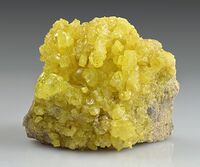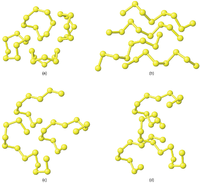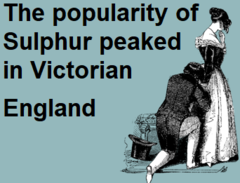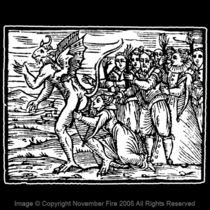Sulphur

- This is an article on the British spelling of the element. For a disambiguation page pointing you back here, see Sulfur.
Sulphur is a chemical element. Element 16 in the Periodic Table is mostly known for its extremely schizophrenic nature. So split is its personality that it cannot even settle on a single spelling of its name; being known as Sulphur by all right-thinking people, as Sulfur by IUPAC and wannabe Brits living on the wrong side of the Atlantic Ocean, and as Brimstone by both Satan and his ungodly adherents when they are cast into a lake of fire.
Classification[edit]
No one can be sure of where to place Sulphur on the Periodic Table, with some claiming that its rightful home is Group 6, others that it should be confined to Group 16, and both eighteenth-century classicists and twenty first century pedants without friends insisting that it is a Chalcogen. Nevertheless, there is general agreement that this abundant p block element should be placed within the Third Period and that it smells like Beelzebub’s ass.
Chemical properties[edit]
Sulphur burns with a blue flame, forming Sulphur Dioxide (SO2) which, if anything, has a suffocating and irritating odour that smells more like Beelzebub’s ass than Sulphur itself. Sulphur is insoluble in water because solubility would be too convenient, but is, instead, soluble in Carbon dioxide just to be annoying.
Given its nature, Sulphur ought to be confined to a -2 oxidation state but that would be to conform to convention. To the annoyance of Chemistry undergraduates everywhere, Sulphur is instead generally found in a positive oxidation state and, though its first and second ionisation energies of 1000 and 2252 kJ/mol suggest that a +2 oxidation state should be common, it makes a point of being more usually found as +4 and +6. What a douche.
With the exception of Noble gases, Sulphur reacts with nearly all other elements in the hope of making them also smell like ass. Its particular favourite partners include Hydrogen – which forms a pungent, rotten-egg ass-gas, Oxygen – making two acidic ass-gases, and Halogens making a range of pungent, acidic ass-gases that, like Britney, are also toxic.
History[edit]
Sulphur seeps from naturally volcanoes and so has been known since time immemorial. Presumably because killing people by asphyxiation, by incinerating them in lava or crushing them beneath the weight of a pyroclastic flow isn’t a big enough punishment, Sulphur ensures that all the above occur while its victims are being made to smell of ass.
Traditional societies made widespread use of volcanic Sulphur, utilising its caustic fumes and ass-stench to both fumigate and bleach clothing and to alleviate sufferering of patients who the doctors of the day felt could beneft from additional ass-stink.
Daoist philosophers in China were interested in Sulphur's strange properties: its low melting point, high flammability and reactivity with many of the metal elements known at that time. Eventually they combined it with Salt Petre and charcoal. Thus gun-powder was born and Sulphur had a hand in yet another method of destroying humanity – albeit with a less than satisfying aroma of ass.
In the Bible, Sulphur (Brimstone) is mostly associated with Hell and also with divine retribution. Famously, the cities of the plain were destroyed with a rain of fire and Brimstone to punish the citizens for the sins of Sodomy and whatever unknown fun the tax-payers of Gomorrah were up to.
Somewhat surprisingly, however, in Isaiah 30:33 we read that: "The breath of Yahweh, like a stream of Brimstone, doth kindle it" - suggesting that even in Bronze Age heaven standards of oral hygiene were as primitive as they were on Earth.
Applications[edit]

Much elemental Sulphur is converted to Sulphuric Acid. This low-odour substance may not be immediately reminiscent of Hell’s sewage-treatment centre but is still useful in disposing of bodies and disfiguring the faces of girls who have rejected incels with particualrly low self-esteem.
Significant quantities of Sulphur are also reacted directly with Methane to form Carbon Disulphide. This useful reagent in Organic Chemistry is surprisingly odourless in its uncontaminated form but, fortunately, is rarely manufactured to a high degree of purity, and so is habitually said to smell like “the well-worn sock of a skunk that has recently walked through its own shit”.
Elemental Sulphur is also useful in the vulcanisation process. This turns soft rubber into the hardened forms more useful in the manufacture of tyres and also imbues tyre fires with the distinctive fragrance of demonic flatulence.
Sulphur Dioxide is bubbled in small quantities through most commercially produced wines to act as a preservative, fungicide and to add to the natural bouquet.
Fortunately, consumers do not have to buy tyres, get drunk or dissolve their disfigured spouses to experience the joy of Sulphur as Sulphur emissions from Hydrocarbon combustion contaminate the air across much of the globe. This Acid Rain-causing issue is responsible for the death of trees too lazy to move out of its path and fish without the will to evolve the legs necessary to crawl from the lakes they’ve been lazing in for millennia. It also has a disastrous effect on marble statues – ironically, often eroding the nose of the notable depicted in stone.
| H | | He | |||||||||||||||
| Li | Be | | B | C | N | O | F | Ne | |||||||||
| Na | Mg | | Al | Si | P | S | Cl | Ar | |||||||||
| K | Ca | Sc | Ti | V | Cr | Mn | Fe | Co | Ni | Cu | Zn | Ga | Ge | As | Se | Br | Kr |
| Rb | Sr | Y | Zr | Nb | Mo | Tc | Ru | Rh | Pd | Ag | Cd | In | Sn | Sb | Te | I | Xe |
| Cs | Ba | Lu | Hf | Ta | W | Re | Os | Ir | Pt | Au | Hg | Tl | Pb | Bi | Po | At | Rn |
| Fr | Ra | Lr | Rf | Db | Sg | Bh | Hs | Mt | Ds | Rg | Cn | Nh | Fl | Mc | Lm | Ts | Og |
| | |||||||||||||||||
| La | Ce | Pr | Nd | Pm | Sm | Eu | Gd | Tb | Dy | Ho | Er | Tm | Yb | ||||
| Ac | Th | Pa | U | Np | Pu | Am | Cm | Bk | Cf | Es | Fm | Md | No | ||||


